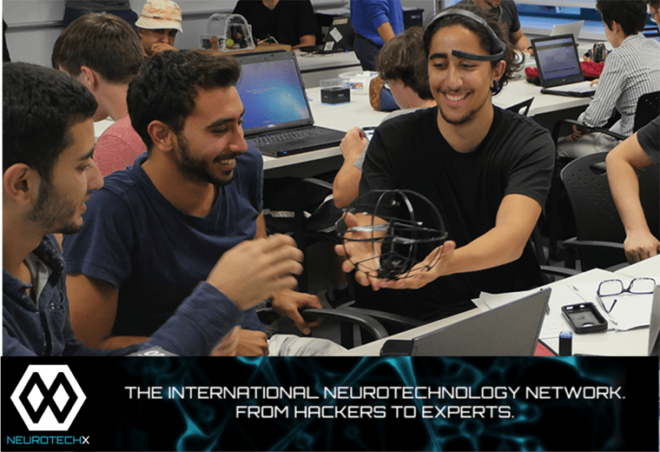NeurotechX brings together people from across disciplines to explore and push the boundaries of neurotechnology
David Doyon and Jacob Flood are hackers. Don’t worry, though, they’re the good kind. In the modern world of tech, “hackers” are explorers. They want to take things apart, see how they tick and learn from existing technologies. Hackers are also innovators. They want to put things back together a little differently and see what difference it makes. Sometimes the differences are small, but the process has the potential to uncover differences that are huge.
A neurohacking story
In the case of Doyon and Flood, the item of interest was the MUSE headband, a consumer-friendly piece of neurotech designed to help meditators reach the sweet spot of inner calm. They used the headset to learn about electroencephalography (EEG) technology, which measures brain activity (read more about EEG and its history). How? They hacked. They took all the little bits apart and looked at how each worked. They tinkered, twiddled and tampered with the tech. They chatted with graduate students and tenured professors of neuroscience. They tinkered some more.
Eventually, they produced something new. The Mindset Headphones aren’t about meditation. They are about productivity. With a sleek design indicative of engineering skill and the brain-tech to help people naturally improve concentration, this up and coming start-up is providing a much needed productivity alternative to a pill-popping culture intent on improving their daily output (read more about the neurotech apps out there here) .
The surprising thing is that Doyon and Flood aren’t neuroscientists. They are engineers, and without the help of neuroscience professionals they never could have produced their stellar piece of neurotech. This is where NeurotechX comes into play.
Bridging divides across disciplines
NeurotechX is a non-profit company dedicated to bringing practical neurotechnology to people outside of the neuroscience field. By working with people across various disciplines – biologists, engineers, artists –who have an interest in the brain, but little access to emerging technologies or professionals in the field, NeurotechX hopes to inspire a new generation of brain tech that can make waves across multiple arenas. Founder Yannick Roy is the passion behind the project.
 Several years ago Roy ran across a series of YouTube videos on neurotechnology and became fascinated with brain technology interfaces. With a background in computer science and electrical engineering, he knew he had something to offer. What he didn’t have was any formal education in neuroscience. He started looking for resources to help him bridge the gap, and found little to help.
Several years ago Roy ran across a series of YouTube videos on neurotechnology and became fascinated with brain technology interfaces. With a background in computer science and electrical engineering, he knew he had something to offer. What he didn’t have was any formal education in neuroscience. He started looking for resources to help him bridge the gap, and found little to help.
“There was nothing really. So I could either go do a Master’s or keep on watching videos on YouTube. These were my options, basically,“ Roy recalls. He wondered how many others found themselves in a similar position – interested in the field, with real skills and creativity to offer, but without the neuroscience background and unable to access the needed information and support. He organized a small club in his hometown of Montreal and the rest, as they say, is history.
Doyon and Flood are fast becoming part of that history. They were two engineers with an interest in neuroscience who took advantage of the resources and connections that NeurotechX as to offer. They came to an event. They kept coming – working with the technology, learning from affiliated mentors and brainstorming with peers and professionals alike. Then they disappeared. When they reemerged, it was with the Mindset Headphone prototype. The take away lesson here is that bright minds, with the right community, can create brilliant, innovative products. NeurotechX is that community.
A fast growing network
With a founding team that includes people from both Montreal and San Francisco, today NeurotechX has chapters in 18 cities throughout North America, Europe, Asia and Latin America, with several more in the works. They have organized over 150 meet-up events, connecting nearly 7000 “neurohackers.” They are also spearheading a quickly growing student club initiative – currently in five universities with an additional five planned in 2017 – and developing on online repository for all things neurotech. Their mission is to help the field progress by integrating people who might not otherwise have the opportunity to contribute. The backbone of their organization are graduate students and postdocs from various disciplines who help one another connect the dots across fields. Though helping to develop new technology and inspiring enthusiasts to put their ideas into action isn’t specifically listed in the mission statement, it has been a welcome outcome.
The possibilities are endless, and every step forward is one more step towards understanding, and possibly enhancing, the human brain. “We are living in such an amazing time in history,” Roy offers. “For the first time ever can we think about reverse engineering ourselves at a neural level and that’s just insane . . . so I definitely want to be part of it and push the field as much as I can.”


Sending some <3
Awesome!!
Amazing!